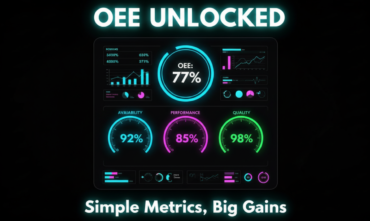
From Vanity Metrics to Victory: How to Build KPIs That Actually Drive Results
Right then. Let’s talk about numbers.
The end of quarter report lands on your desk. Turnover is up. Total units shipped are at a record high. The website has seen a surge in traffic. On the surface, it’s all good news. You lean back in your chair, take a sip of tea, and feel that brief, warm glow of success. We’ve all been there. It feels great.
But then, a nagging feeling creeps in. Why, if turnover is up, are the margins feeling tighter than ever? If you’re shipping more units, why is the operations manager looking permanently stressed and talking about increased rework? And what did all that website traffic actually do?
This, my friend, is the siren song of vanity metrics. They are the numbers that look impressive in a PowerPoint presentation but don’t actually tell you much about the health of your business. They make you feel good, but they don’t help you make good decisions. They are the business equivalent of counting calories without ever looking at the nutritional information.
The truth is, in the world of manufacturing, where every penny and every second counts, focusing on the wrong numbers can be more than just a distraction. It can actively hide serious problems until it’s too late. It can lead you to invest in the wrong areas, reward the wrong behaviours, and ultimately, steer the entire ship in the wrong direction.
But how do you cut through the noise? How do you move from tracking what’s easy to measure to measuring what truly matters? Over the years, I’ve found it comes down to asking the right questions. So, we’re going to walk through a simple, three question framework designed to help you identify the Key Performance Indicators, or KPIs, that will actually drive your manufacturing business forward.
Why Vanity Metrics Are a Dangerous Distraction
Before we get to the solution, we need to properly understand the problem. What exactly is the difference between a vanity metric and a real, hardworking KPI?
A vanity metric is a surface level number. It’s often big, impressive, and easy to track. Think total revenue, number of employees, or social media followers. It tells you that something happened, but it gives you zero context as to why or whether it was a good thing.
A Key Performance Indicator, on the other hand, is directly tied to a strategic business objective. It’s actionable. When a KPI moves up or down, you know whether you’re getting closer to or further from a specific goal, and it often suggests what action you need to take.
Let’s look at some common examples in a manufacturing setting.
Vanity Metric: Total Units Produced.
This number looks fantastic on a chart that goes up and to the right. The board loves it. But what does it really tell you? Nothing about quality. Nothing about efficiency. You could be producing thousands of units with a 20% defect rate that requires costly rework, or you could be running machines into the ground with no preventative maintenance, setting yourself up for a catastrophic failure next month.
A Better KPI: First Pass Yield (FPY).
This measures the percentage of products that are manufactured to specification, without any rework, the first time through the process. A high FPY tells you your processes are stable, your quality is high, and your efficiency is strong. If FPY drops, you know you have a problem on the line that needs immediate investigation. It’s a number that prompts action.
Vanity Metric: Website Traffic.
Your marketing team reports a 50% increase in visitors to your website. Great. But who were they? Were they potential customers in the UK looking for a new component supplier, or were they students from another continent doing research for a project? Did any of them download a spec sheet, request a quote, or call your sales team? Without that context, the number is meaningless.
A Better KPI: Qualified Lead Velocity Rate.
This measures the month over month growth in the number of genuine, qualified leads your marketing and sales teams are generating. It tells you if your pipeline is growing. It’s a direct indicator of future sales potential. It’s a number that the sales director can actually use to forecast and plan.
The danger of vanity metrics is that they create a false sense of security. When the big numbers look good, it’s easy to ignore the underlying issues. It’s like the doctor telling you your weight is stable without checking your blood pressure. You might look fine on the outside, but inside, problems could be brewing. Chasing these metrics encourages teams to focus on activities that boost the number, not activities that improve the business.
Understanding the Power of Leading vs. Lagging KPIs
Okay, so we agree we need to move beyond vanity. The next crucial step is to understand that not all true KPIs are created equal. They generally fall into two categories: lagging and leading. Getting the balance right between these two is probably the single most important part of building a useful dashboard.
Lagging indicators are the ones we’re all most familiar with. They measure outcomes. They are backward looking, telling you the result of things that have already happened. Think of them as the final score of a football match.
- Monthly Net Profit
- Customer Churn Rate
- On Time In Full (OTIF) Delivery Percentage
- Total Scrap Value
These are all incredibly important. They tell you if you won or lost the game. They validate your strategy and tell you if your past efforts paid off. The problem is, by the time you measure them, the game is over. You can’t go back and change the outcome. If your OTIF for last month was a dismal 75%, you can’t do anything to fix it. The deliveries are already late.
Leading indicators, on the other hand, are predictive. They measure the inputs and behaviours that will likely lead to a future result. They are the things you can influence right now to change the final score. In our football analogy, this would be things like shots on goal, pass completion percentage, or time of possession.
- Sales Pipeline Velocity (how quickly deals are moving through stages)
- Percentage of Preventative Maintenance Tasks Completed on Time
- Average Supplier Quality Score
- Number of Employee Suggestions Implemented
These are the levers you can pull. If you see that your team is falling behind on preventative maintenance, you can intervene immediately. You can allocate more resources or adjust schedules to get back on track and prevent the future machine downtime that would wreck your lagging KPIs. If your sales pipeline is looking thin, you know you need to ramp up marketing or prospecting efforts now to avoid a bad sales quarter in three months.
To be honest, most businesses I’ve worked with are drowning in lagging indicators. They spend hours every month poring over reports that tell them what went wrong last month. Proactive, successful businesses, however, are obsessed with their leading indicators. They use them as an early warning system, allowing them to solve problems before they become catastrophes.
The 3 Questions to Find the KPIs That Truly Matter
So, how do we get there? How do we build a dashboard that gives us this balanced, forward looking view? It starts by ignoring the giant list of 100 possible metrics you could track and instead asking three simple, powerful questions.
Question 1: What are your core strategic objectives?
This sounds obvious, but it’s the step most often missed. You cannot choose a Key Performance Indicator if you don’t first know what performance you’re trying to indicate. Before you measure anything, you have to be brutally clear about what you are trying to achieve as a business.
And I don’t mean vague goals like “be the best” or “grow the company.” I mean specific, written down objectives. For example:
- Objective A: Increase overall profitability by 5% in the next fiscal year.
- Objective B: Reduce customer reported defects by 15% within six months.
- Objective C: Successfully launch the new X-series product line and achieve £1M in sales in its first year.
Your KPIs must flow directly from these objectives. If a metric doesn’t help you track your progress towards one of these goals, then why are you tracking it? It’s just noise. This first question forces you to connect every number on your dashboard to a genuine business priority. It’s the ultimate filter.
Question 2: Which KPIs directly measure progress toward these objectives?
Once you have a clear objective, you can start brainstorming metrics that measure it. The key here is to choose KPIs that are actionable, relevant, and, of course, measurable. You need to avoid the temptation to pick a metric just because it “looks good” or is easy to get the data for.
Let’s take Objective B: Reduce customer reported defects by 15%.
- A poor KPI choice would be “Total Units Shipped.” As we discussed, this doesn’t tell you anything about quality.
- A good lagging KPI would be “Customer Defect Rate” or “Number of Warranty Claims.” This directly measures the outcome you want to influence. It tells you if you’re succeeding.
- A good leading KPI would be “First Pass Yield,” “In Process Inspection Failure Rate,” or “Percentage of Staff with Up to Date Quality Training.” These are the activities that prevent defects from ever reaching the customer. If these numbers are heading in the right direction, your lagging indicator is almost certain to follow.
The litmus test for a good KPI is this: if this number changes, will it trigger a specific action or decision? If your In Process Inspection Failure Rate spikes, does that trigger a review of the machine setup or the raw material batch? If the answer is yes, you’ve got a winner. If the answer is no, it’s probably a vanity metric in disguise.
Question 3: Are you balancing leading and lagging KPIs?
This final question is your sense check. Look at the KPIs you’ve chosen for each objective. Do you have a healthy mix of both rearview mirror metrics and forward looking predictors?
- Lagging KPIs are for validation. They confirm whether your strategy worked. They are perfect for reporting to the board and for celebrating successes.
- Leading KPIs are for management. They are the numbers your operational teams should be looking at daily or weekly to make real time adjustments.
A dashboard with only lagging indicators is like driving a car using only the rearview mirror. You know exactly where you’ve been, but you have no idea what’s coming. A dashboard with only leading indicators can feel a bit abstract; you’re tracking a lot of activity, but you’re not sure if it’s producing the right results.
The magic happens when you pair them. You track Preventative Maintenance Compliance (leading) to influence Machine Uptime (leading), which in turn drives On Time Delivery (lagging) and ultimately, Customer Satisfaction (lagging). Each step in the chain predicts the next, giving you a complete and powerful view of your operations.
Best Practices for Making Your KPIs Work
Identifying the right KPIs is half the battle. The other half is embedding them into the culture of your business so they actually get used.
First, set realistic but challenging targets. A target of “100% On Time Delivery” might be demoralising if you’re currently at 80%. A better approach might be to target 85% this quarter, and 90% the next. The goals should stretch your teams, not break them.
Second, review them regularly. KPIs aren’t meant to be carved in stone. Your business priorities will change. Hold monthly or quarterly KPI review meetings. Ask what the numbers are telling you. Are the targets still right? Are we still measuring the most important things? Be prepared to kill off KPIs that are no longer serving you.
Third, communicate and foster ownership. The person on the shop floor needs to understand why their machine’s OEE (Overall Equipment Effectiveness) matters. Show them how it connects to the company’s goal of improving profitability. Give teams ownership of the KPIs they can influence. When people feel responsible for a number, they will move heaven and earth to improve it.
Finally, and most importantly, use KPIs as triggers for action, not just as a report card. A dashboard should be the start of a conversation, not the end of one. When a KPI turns red, it shouldn’t be about blame. It should be a signal for the team to swarm the problem, understand the root cause, and implement a solution.
Practical Examples for Your Manufacturing Business
Let’s bring this to life with some concrete examples across different functions.
Operations:
- Leading: Overall Equipment Effectiveness (OEE), Schedule Adherence, First Pass Yield.
- Lagging: On Time In Full (OTIF), Cost Per Unit, Scrap Rate.
Sales:
- Leading: Quote to Win Ratio, Sales Pipeline Value, Average Time to Close a Deal.
- Lagging: Total Revenue, Average Order Value, Customer Acquisition Cost.
Marketing (for Manufacturers):
- Leading: Number of Qualified Leads from Website/Trade Shows, Spec Sheet Download Rate.
- Lagging: Marketing Spend per Acquired Customer, Customer Lifetime Value.
Finance:
- Leading: Days Sales Outstanding (DSO), Inventory Turns.
- Lagging: Gross Profit Margin, EBITDA, Return on Capital Employed (ROCE).
Notice how for each area, there’s a mix of predictive activities and final outcomes. That’s the balance you’re aiming for.
Bringing It All Together
Look, it’s easy to get lost in a sea of data. It’s tempting to track dozens of metrics because the software makes it possible. But more data doesn’t mean more clarity. Often, it just means more noise.
Chasing vanity metrics feels productive, but it’s a trap. It leads to busy work, not effective work. It masks underlying problems and can lull you into a dangerous sense of complacency.
The power lies in simplicity and focus. By using this three question framework, you can cut through the clutter and build a small, powerful set of KPIs that are tightly aligned with your real business goals.
- What are our core strategic objectives?
- Which KPIs directly measure our progress?
- Are we balancing leading and lagging indicators?
Start small. Pick one critical business objective and apply these questions to it. Build out a mini dashboard with just three or four carefully chosen leading and lagging KPIs. Use them, talk about them, and see what a difference it makes.
So I invite you to do just that. Go back to your desk, pull up your current management report or dashboard, and for each number you see, ask yourself those three questions. Does it pass the test? Or is it just there to make you feel good? The answers might just change the way you run your business. To see how these principles can be applied directly to your organisation, I’d encourage you to explore the Goal Deployment Programme at https://tcmuklimited.co.uk/goal-deployment-programme/. It’s designed to help manufacturers like you make this transition from theory to reality.
More Blog Posts







To leave me a message or book a return call at a time that suits you








